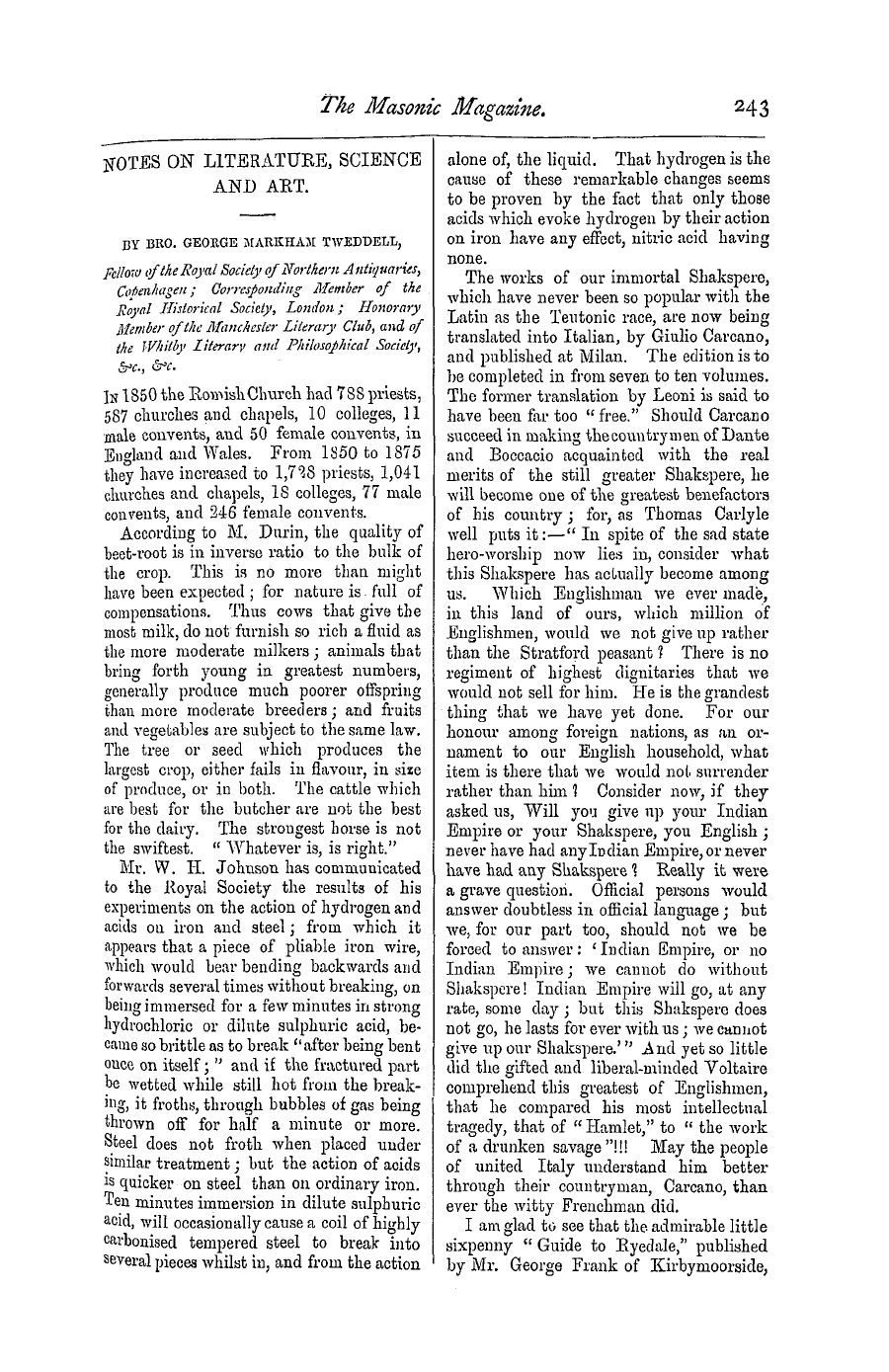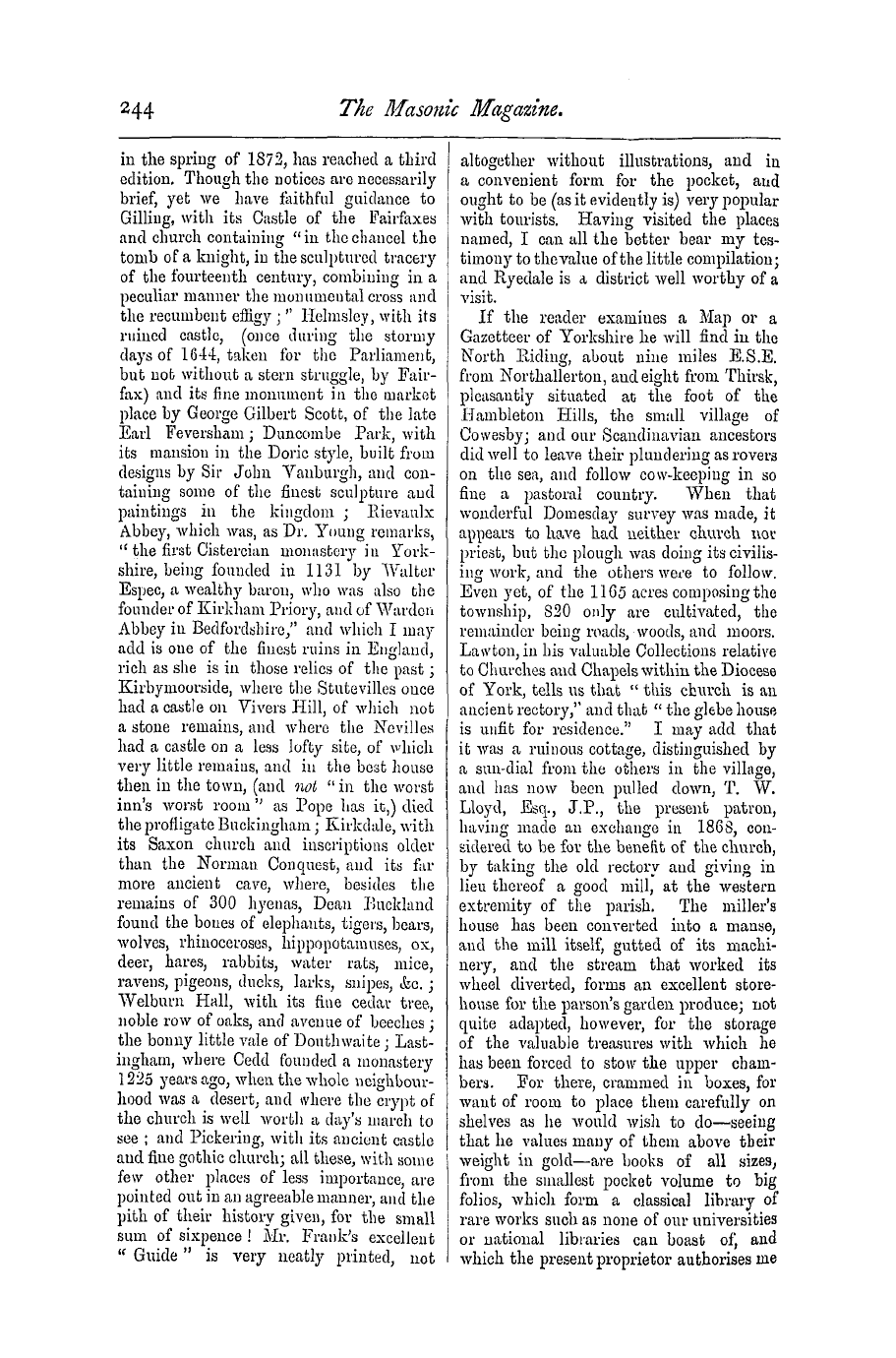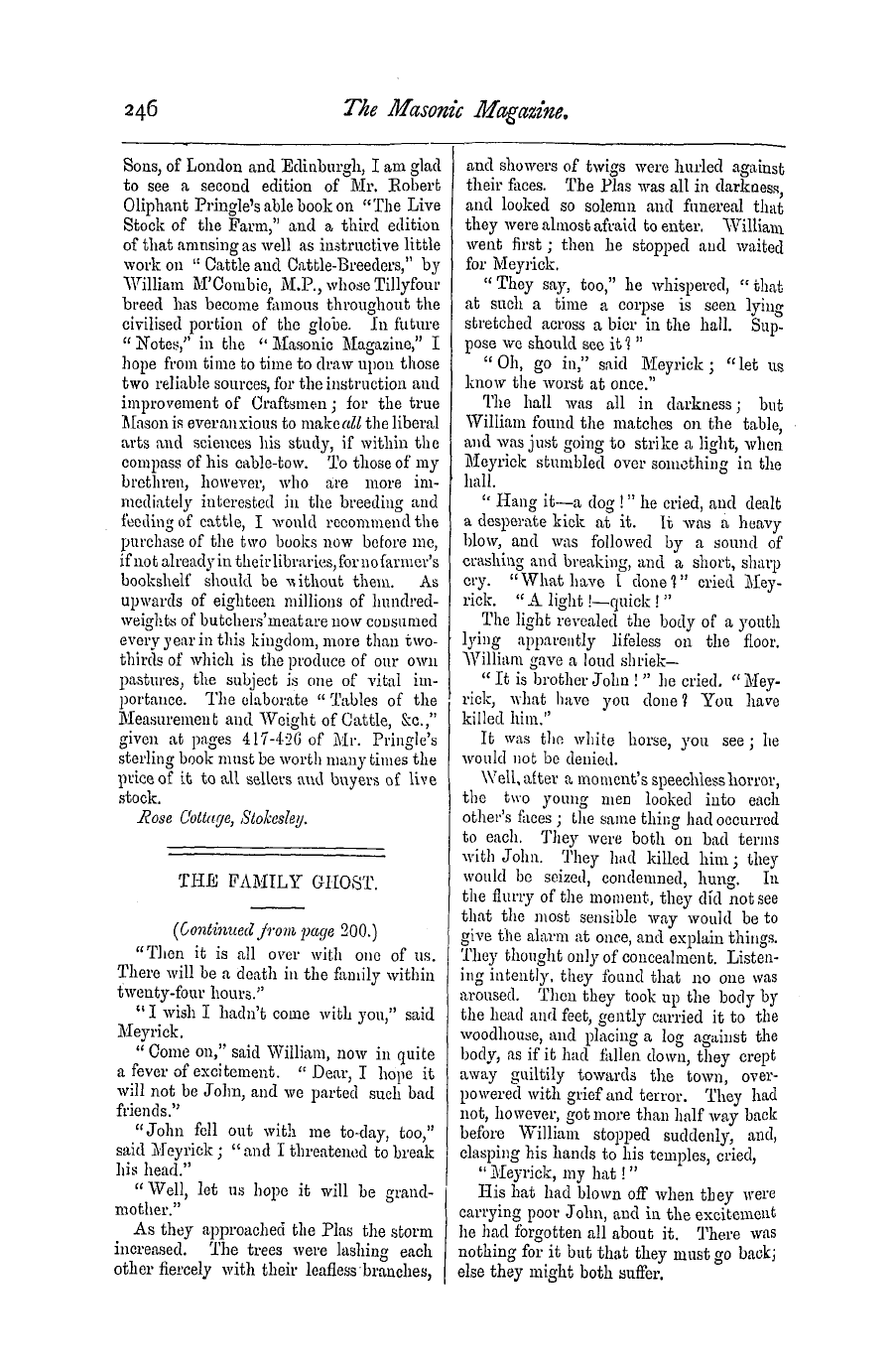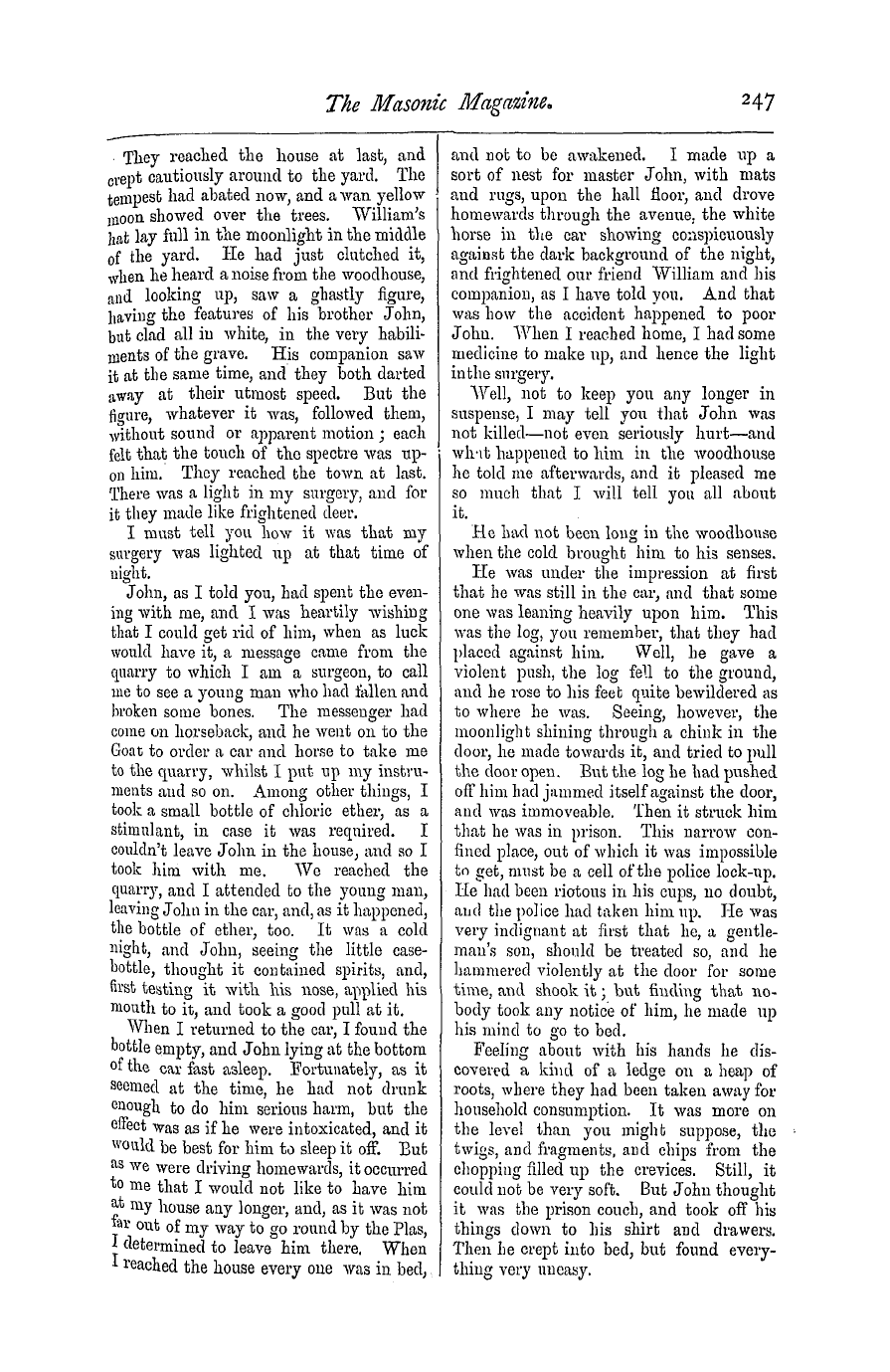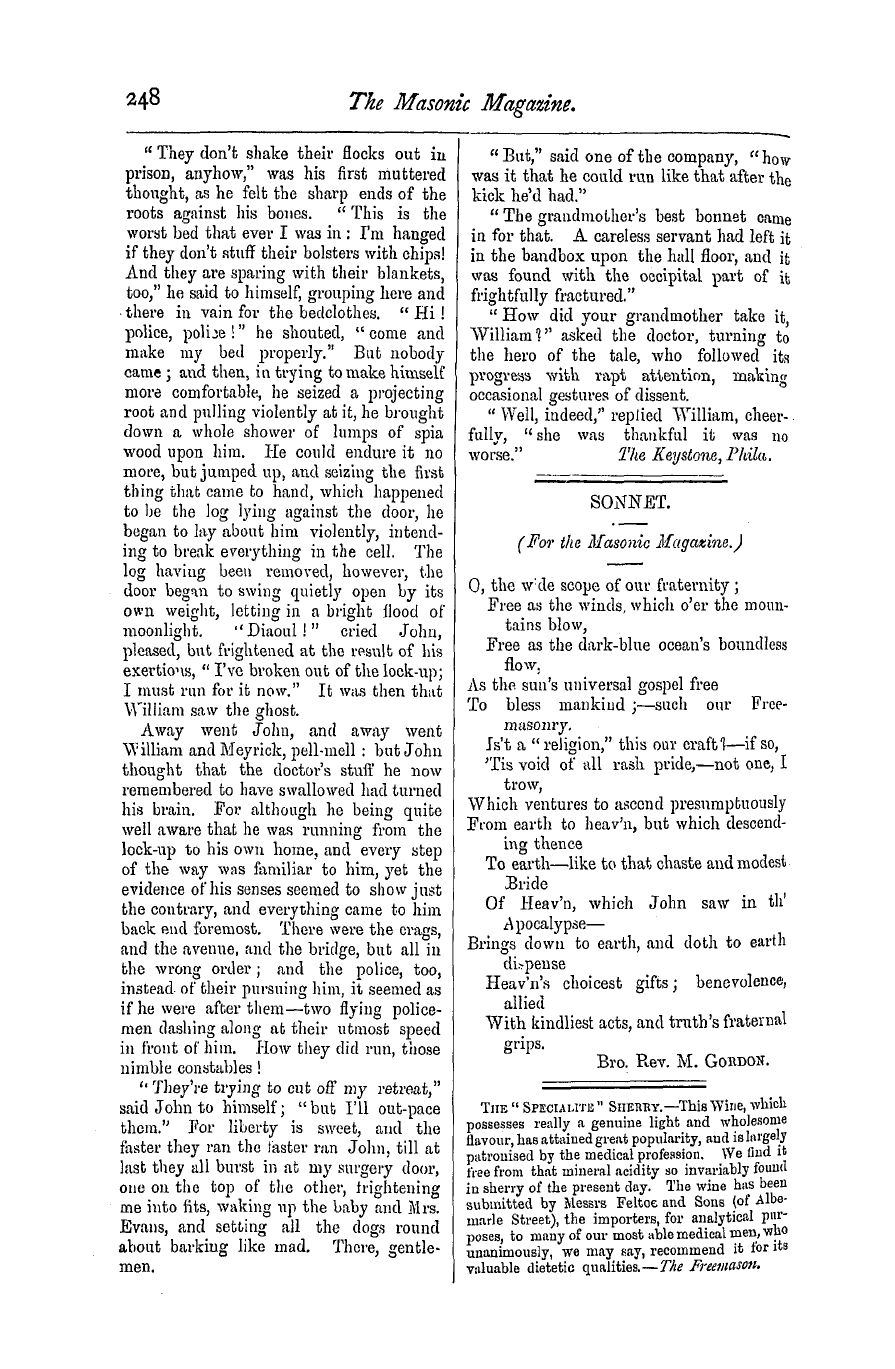Note: This text has been automatically extracted via Optical Character Recognition (OCR) software.
The Early History And Antiquities Of Freemasonry.*
his indebtedness to fellow labourers , and his careful discrimination betAveen fact and fiction must secure for him the respect of all Masonic students . We are decidedl y of the opinion that the Avork is indispensable to the library of all thoughtful
Craftsmen , and especially to those AVIIO make the history of the Fraternity their special study . The voluminous extracts , registers , records and other documents are most artistically Avoven into a homogeneous substratumwhich support the arguments of
, the treatise and unite to make it , Avithout doubt , one of the most attractive , reliable and exhaustive Avorks on Freemasonry Avhich have appeared during this century , and constitute it one of the most masterly productions on the subject which it has
ever been our pleasure to peruse . We thank Brother Fort most Avarmly for the information and pleasure thus obtained , and Ave hope that a similar experience will fall to the lot of many in this country ( and also in the United States ) , for the volume
should be circulated by thousands . We should much like to present several extracts from the Avork , but can scarcely UOAV spare the time to do more than cull tho
folloAving extracts , which abundantl y support Bro . Woodford and ourselves in upholding the Guild theory , and Avhich in a most scholarlike manner place the origin of Freemasonry on a firm basis . " These guilds in their organized forms , so far at least as was essential to their cohesion
, introduced naturally such elements , eliminated from civil society , of that age , as tended to direct their establishment to practical purposes . For instance , Freemasonry borrowed , as before suggested , the outlines of its constitution from the
three amalgamated principles Avhich Avere fundamental in the earl y Middle Ages : the autocratic , personal independence , and ecclesiastical . It was necessarily tinctured Avith the mythological superstitions , which still retained at this period a vigorous
hold on the people of Northern Europe . As the guilds tamed their ori gin back into the twili ght of time , and were coeval Avith the first forms of Germanic society , consequentl y many fragments of heathen rites and observances passed Avith them
into succeeding mediteval fraternities . It may therefore be safely alleged that Teutonic mythology , from its earliest contact with the Eastern builders in the fifth century ,
and through the line of centuries following , has contributed very largely to Masonic symbolism . " In terminating the first portion of the History the author thus remarks : — " If Ave oast our eyes backAvard over the several
pathways travelled , Ave find , amid the varied circumstances of local and national life , much that points to an association held in check and regulated by secret rules , which vitalized the most distant and distinct branches . These pointswhich scattered
, bodies of mediteval masons present in common , are not the result of accident or the Avork of chance . EveryAvhere we have seen , or shall hereafter see , a strange conformity , spreading regularly and Avith an unalterable consistency , through the ancient
Masonic corporationsof Europe . This unity could not have preserved uninterrupted existence , had it depended upon the transient requirements of any age or nation . Other guilds and associations , established for purposes of temporary and local interest , have long since passed away . Unnumbered corporations , nurtured into
into vitality by the troubled times of the Middle Ages , whose duration was the result of fleeting necessity , have vanished , while the mediaeval guilds of Masons still survive in speculative Freemasonry . With a consistent harmony , the formularies of internal governmentand a rigid adherence to
pre-, scriptive usage , such as guided ancient lodges in bowing out of polished stone the elegant designs of the master builder are preserved Avith zealous vigilance by their successors . Speculative Masonry has perpetuated intact for centuries that which
has come down from the very twilight of time . In passing through the various nationalities which have successively fallen to decay , this brotherhood has survived , and , through the long line of ages , continued to guard the relics of a remote
antiquity . " We havu only to state that Sherman ct Co . were the printers , and T . Fagan & Son the eleotrotypers , to assure our readers that the typographical merits of the volume will not disgrace the eminent American and English publishers .
We hope soon to again allude to Brother Fort ' s Masonic History , and meantime Avish it the success it so thoroughly merits .
Note: This text has been automatically extracted via Optical Character Recognition (OCR) software.
The Early History And Antiquities Of Freemasonry.*
his indebtedness to fellow labourers , and his careful discrimination betAveen fact and fiction must secure for him the respect of all Masonic students . We are decidedl y of the opinion that the Avork is indispensable to the library of all thoughtful
Craftsmen , and especially to those AVIIO make the history of the Fraternity their special study . The voluminous extracts , registers , records and other documents are most artistically Avoven into a homogeneous substratumwhich support the arguments of
, the treatise and unite to make it , Avithout doubt , one of the most attractive , reliable and exhaustive Avorks on Freemasonry Avhich have appeared during this century , and constitute it one of the most masterly productions on the subject which it has
ever been our pleasure to peruse . We thank Brother Fort most Avarmly for the information and pleasure thus obtained , and Ave hope that a similar experience will fall to the lot of many in this country ( and also in the United States ) , for the volume
should be circulated by thousands . We should much like to present several extracts from the Avork , but can scarcely UOAV spare the time to do more than cull tho
folloAving extracts , which abundantl y support Bro . Woodford and ourselves in upholding the Guild theory , and Avhich in a most scholarlike manner place the origin of Freemasonry on a firm basis . " These guilds in their organized forms , so far at least as was essential to their cohesion
, introduced naturally such elements , eliminated from civil society , of that age , as tended to direct their establishment to practical purposes . For instance , Freemasonry borrowed , as before suggested , the outlines of its constitution from the
three amalgamated principles Avhich Avere fundamental in the earl y Middle Ages : the autocratic , personal independence , and ecclesiastical . It was necessarily tinctured Avith the mythological superstitions , which still retained at this period a vigorous
hold on the people of Northern Europe . As the guilds tamed their ori gin back into the twili ght of time , and were coeval Avith the first forms of Germanic society , consequentl y many fragments of heathen rites and observances passed Avith them
into succeeding mediteval fraternities . It may therefore be safely alleged that Teutonic mythology , from its earliest contact with the Eastern builders in the fifth century ,
and through the line of centuries following , has contributed very largely to Masonic symbolism . " In terminating the first portion of the History the author thus remarks : — " If Ave oast our eyes backAvard over the several
pathways travelled , Ave find , amid the varied circumstances of local and national life , much that points to an association held in check and regulated by secret rules , which vitalized the most distant and distinct branches . These pointswhich scattered
, bodies of mediteval masons present in common , are not the result of accident or the Avork of chance . EveryAvhere we have seen , or shall hereafter see , a strange conformity , spreading regularly and Avith an unalterable consistency , through the ancient
Masonic corporationsof Europe . This unity could not have preserved uninterrupted existence , had it depended upon the transient requirements of any age or nation . Other guilds and associations , established for purposes of temporary and local interest , have long since passed away . Unnumbered corporations , nurtured into
into vitality by the troubled times of the Middle Ages , whose duration was the result of fleeting necessity , have vanished , while the mediaeval guilds of Masons still survive in speculative Freemasonry . With a consistent harmony , the formularies of internal governmentand a rigid adherence to
pre-, scriptive usage , such as guided ancient lodges in bowing out of polished stone the elegant designs of the master builder are preserved Avith zealous vigilance by their successors . Speculative Masonry has perpetuated intact for centuries that which
has come down from the very twilight of time . In passing through the various nationalities which have successively fallen to decay , this brotherhood has survived , and , through the long line of ages , continued to guard the relics of a remote
antiquity . " We havu only to state that Sherman ct Co . were the printers , and T . Fagan & Son the eleotrotypers , to assure our readers that the typographical merits of the volume will not disgrace the eminent American and English publishers .
We hope soon to again allude to Brother Fort ' s Masonic History , and meantime Avish it the success it so thoroughly merits .
















































